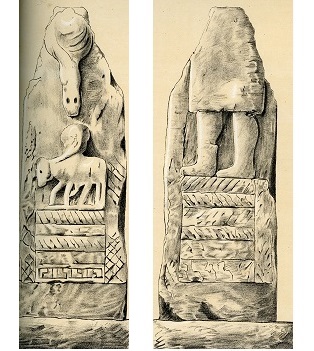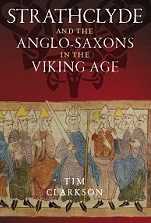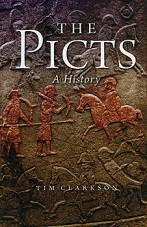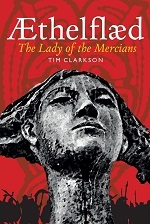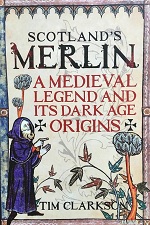
The main cemetery for the community of Lochwinnoch in Renfrewshire sits high on a hillside on the edge of the village, above the west bank of the River Calder. Among the numerous memorials and tombstones is a strange-looking object known as the ‘Dumb Proctor’ which stands like a sentinel among the graves of the Ewing family. The old Scots word ‘proctor’, a shortened form of ‘procurator’, refers (in most instances) to a religious official. This one is ‘dumb’ because it’s made of sandstone. It does indeed resemble a stooping, hooded figure. To local historian Derek Parker, who described the stone some years ago, it seemed like “a brooding monk silently summoning sinners to repentance”.
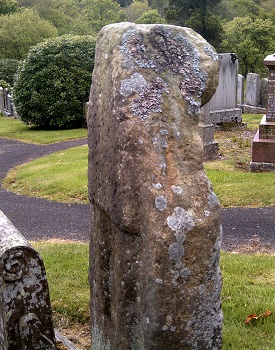
‘a brooding monk’
The front of the stone is dominated by a large boss in the upper section, below which is a serpent. Beneath the serpent is a horseman, now much weathered, above a square panel containing five horizontal bars. A report from 1890 described a border of Celtic interlace but no trace of any such pattern is visible today. On the reverse is the lower part of a large human figure wearing a long tunic or robe.

Although the Dumb Proctor was once regarded as mysterious, we now know that it is a Christian monument of the early medieval period. The serpent is the last survivor of a quartet which once formed a cross around the central boss. These creatures symbolize redemption and rebirth, the analogy being the periodic shedding of their old skin. Arranged in a cross-shape they display the Christianity of the wealthy patrons who commissioned the stone. Likewise, the large figure carved on the back may represent the Crucified Christ, by analogy with examples from elsewhere.

The horseman, although now indistinct, conforms to a type seen on stones of the ‘Govan School’ of sculpture. Govan appears to have been the premier stonecarving centre in the kingdom of Strathclyde during the 9th-11th centuries. Artistic styles developed at Govan were disseminated throughout the kingdom, appearing on monuments in frontier regions such as Ayrshire and the shores of Loch Lomond. The area around Lochwinnoch must at one time have lain within the kingdom’s southwestern border, probably close to an interface between the Strathclyde Britons and the Gaelic-speaking Gall Gaidhil who had been colonising Ayrshire since the 9th century. Lochwinnoch lay on an important route connecting the core of Strathclyde to the Irish Sea coastlands. It is possible that the Dumb Proctor was originally placed as a wayside cross along this route, perhaps to mark a boundary. The horseman – a mounted warrior – indicates that this was a secular monument rather than an ecclesiastical one.

The Dumb Proctor owes its current shape to alterations made since its discovery in the early 19th century. It was unearthed in a field on the old farm of the Ewings, who placed it in their garden before re-shaping it as a gravestone. How much of the monument was lost during this process is unknown, for there is no contemporary illustration from the time of discovery. Nevertheless, the surviving portion was correctly identified as the upper part of a free-standing cross as far back as 1890. More recently, Alan Macquarrie proposed that the cross-head was probably similar to others of the Govan sculptural style, such as the still-intact example from Barochan (now in Paisley Abbey). The device of four serpents emerging from a central boss is reminiscent of the Sun Stone at Govan.
A reconstruction drawing of the Dumb Proctor appears on page 17 in the published version of Alan Macquarrie’s Govan Lecture for 2005. This was redrawn by Ingrid Shearer for a new book by Derek Alexander and Gordon McCrae on the history of Renfrewshire. My own attempt at a reconstruction can be seen below. It’s how I imagine the Dumb Proctor might have looked today if it still had its cross-head (in which case I suppose it wouldn’t look much like a proctor at all).

My ‘reconstruction’ of the Dumb Proctor.
* * * *
Notes & references
Alan Macquarrie, Crosses and Upright Monuments in Strathclyde: Typology, Dating and Purpose (Govan: Friends of Govan Old, 2006), pp.17-18
Derek Alexander & Gordon McCrae, Renfrewshire: a Scottish County’s Hidden Past (Edinburgh: Birlinn, 2012), pp.91-2.
[In my opinion, this book is an essential resource for anyone researching the kingdom of Strathclyde]
Derek Parker, ‘The Timeless Message of the Dumb Proctor’, Chatterbox, no.180 (2008)
[Chatterbox is a newsletter published by Lochwinnoch Community Council]
See also the entry for the Dumb Proctor on the Canmore database.
Allen and Anderson’s Early Christian Monuments of Scotland makes no mention of the Dumb Proctor, despite including Renfrewshire’s other surviving monuments of the Govan School. The Lochwinnoch volume of Archaeological and Historical Collections Relating to the County of Renfrew (the 1890 report mentioned above) had recognized the Proctor as an early Christian stone a dozen years before the compilation of ECMS. Were Allen and Anderson unaware of this?
* * * * * * *
Read Full Post »
